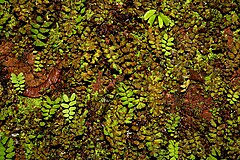en
names in breadcrumbs


Pteridaceae is a family of ferns in the order Polypodiales,[2] including some 1150 known species in ca 45 genera[3] (depending on taxonomic opinions), divided over five subfamilies.[4] The family includes four groups of genera that are sometimes recognized as separate families: the adiantoid, cheilanthoid, pteridoid, and hemionitidoid ferns. Relationships among these groups remain unclear, and although some recent genetic analyses of the Pteridales suggest that neither the family Pteridaceae nor the major groups within it are all monophyletic, as yet these analyses are insufficiently comprehensive and robust to provide good support for a revision of the order at the family level.
Members of Pteridaceae have creeping or erect rhizomes. The leaves are almost always compound and have linear sori that are typically on the margins of the leaves and lack a true indusium, typically being protected by a false indusium formed from the reflexed margin of the leaf.

As traditionally defined, the groups within Pteridaceae are as follows:
Based on phylogenetic research, Christenhusz et al. (2011) divided the Pteridaceae genera into five subfamilies.[11] These roughly correspond with the groups listed above, with the main difference being that adiantoid and vittarioid ferns are combined under the Vittarioideae subfamily name. The approach was followed by the Pteridophyte Phylogeny Group classification of 2016 (PPG I).[2]
Smith et al. (2006) carried out the first higher-level pteridophyte classification published in the molecular phylogenetic era.[12] Smith referred to the ferns as monilophytes, dividing them into four groups. The vast majority of ferns were placed in the Polypodiopsida.
In 2016, the Pteridophyte Phylogeny Group divided order Polypodiales into six suborders. Pteridaceae is the sole family in suborder Pteridiineae, with 52 genera. The suborder has the same circumscription as Smith et al. used for the family. The phylogenetic relationship between these six suborders is shown in this cladogram:[2]
PolypodialesPteridiineae
The oldest fossil of the family is Heinrichsia from the early Late Cretaceous (Cenomanian) aged Burmese amber of Myanmar, which cannot be assigned to modern grouping of the family. Molecular clock evidence suggests a diversification of the family during the Late Cretaceous.[13]
Phylogeny of Pteridaceae.
Mostly terrestrial or epipetric (growing on rock).
 Adiantum lunulatum
Adiantum lunulatum Pteridaceae is a family of ferns in the order Polypodiales, including some 1150 known species in ca 45 genera (depending on taxonomic opinions), divided over five subfamilies. The family includes four groups of genera that are sometimes recognized as separate families: the adiantoid, cheilanthoid, pteridoid, and hemionitidoid ferns. Relationships among these groups remain unclear, and although some recent genetic analyses of the Pteridales suggest that neither the family Pteridaceae nor the major groups within it are all monophyletic, as yet these analyses are insufficiently comprehensive and robust to provide good support for a revision of the order at the family level.